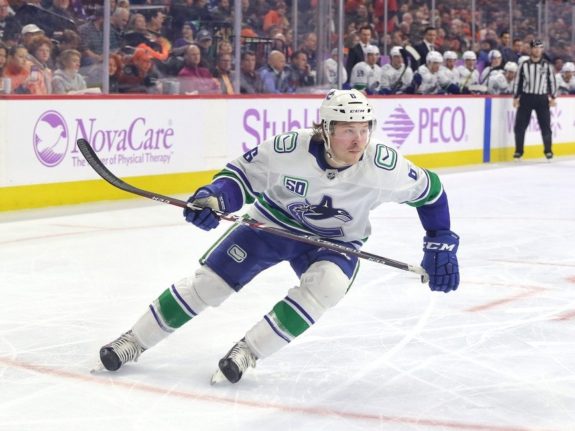The Vancouver Canucks have started the 2021-22 season with a record of 3-3-1, giving them a .500 win percentage as of Oct. 28. Although it’s early in the season, a way the Canucks could improve is by giving “the Brockstar,” Brock Boeser, more time on the power play.
How the Cancuks are Dividing Power-Play Time
Throughout the Canucks first seven games of the season, the team has spent 49:58 on the power play, ranking first in the league for time spent on the power-play time as of Oct.27. The team’s top five forwards in power-play time on ice (power play TOI) per game are as follows.
| Player | Power Play TOI | Games Played |
| J.T. Miller | 4:27 | Seven |
| Elias Pettersson | 4:31 | Seven |
| Bo Horvat | 4:13 | Seven |
| Alex Chiasson | 3:40 | Six |
| Boeser | 2:57 | Four |
Here is how Boeser’s power-play production stacks compared to his teammates thus far in 2021-22:
| Statistic | Ranking |
| Power Play Goals per 60 (PPG/60) | Second |
| Power Play Points per 60 (PPP/60) | Fourth |
| Power Play Goals (PPG) | Tied for second |
| Power Play Points (PPP) | Tied for fourth |
Overall, Boeser ranks fifth among Vancouver’s forward corps in his average amount of power play TOI per game, averaging almost a minute less (43 seconds) than the fourth-placed Chiasson. This is despite the fact that Boeser’s power-play production ranks among the team’s top four forward producers. Even though he has missed three games, he is tied with Horvat and Pettersson in PPG and has notched more than Miller thus far. In total, Boeser has produced just one PPP this season, but among the Canucks’ forwards, only Miller (four), Chiasson (three), and Pettersson (three) have more than two PPP, showing that Boeser is not far behind them, whilst having played fewer games.
Canucks’ 2021-22 Power Play Ranking
The Canucks power-play unit has capitalized on 23.1% of their opportunities this season. This is a respectable total, and as of Oct.27, ranked 14th in the league. However, there is room for improvement. Considering Boeser led the Canucks in PPG last season (2020-21), he could certainly give the team a scoring punch should he be given more power-play time.
Boeser is a Known Sniper
Over the past five seasons, Boeser has scored 95 goals, which ranks 48th in the league in that timeframe. He is the only Canuck in the top-50 during this period, meaning he is one of, if not Vancouver’s most established sniper.

Boeser’s 0.383 goals per game during this period is tied for 35th in the league during the past five years, just behind Pettersson’s 0.384. Additionally, Boeser is highly regarded in goals per 60, as he ranked 43rd in the NHL in this regard. Although he’s not a 50-goal scorer, he is one of the NHL’s more consistent goal scorers, meaning it should be a no-brainer for him to be getting top power-play time.
The clip above highlights where Boeser should be playing on the power play. He is a known sniper and should be given the opportunity to unleash his shot. As my THW colleague Matthew Zator recently described, the Canucks could run the power play through Boeser and Pettersson’s deadly one-timers. Boeser is right-handed, while Pettersson is left-handed, meaning the team could have two premiere scoring threats options out on the top power-play unit.
Which Canuck’s Power-Play Time Would be Relegated?
The main question this idea poses is, whose power-play time should be relegated? The simplest solution would be Chiasson. Although he is a good net-front presence, the 31-year-old could have his power-play time reduced without fans batting their eyes, as some people are already questioning this decision. Instead of having Chiasson average almost a minute more of power-play time per game than Boeser, it would make more sense for Boeser to get more playing time as he is a greater scoring threat. Also, being just 24-years-old means Boeser has more of an opportunity to grow into a power-play scoring threat for years to come than Chiasson.

However, Chiasson does lead Vancouver in PPG (two), PPG/60 (5.450) and power-play points per 60 (PPP/60) with 8.176. One could use these facts to argue he is deserving of his current role. Another option to bump down to the second power-play unit is Horvat. The reason Boeser was sent down to the second unit in the first place was to balance the units. In both 2019-20 and 2020-21, the Canucks’ top power-play quartet of Horvat, Miller, Pettersson and Boeser was successful, but in 2020-21 the secondary power-play unit struggled, hence the team’s power play percentage dropping from 24.1% (fourth best in the league in 2019-20) to 17.1% (ranked 25th in 2020-21) just one season later.
You may also like:
- Canucks’ Rick Tocchet Deserves to Win Jack Adams Award
- Canucks News & Rumors: Demko, Joshua, Lekkerimaki & More
- NHL Rumors: Canucks, Capitals, Oilers, Flames, Maple Leafs
- Hockey’s Scariest Goalie Mask and the Man Behind It
- 2024 Could Finally End Canada’s Stanley Cup Drought
Horvat is the other possible player to be bumped down in place of Boeser because he is the least productive of the four forwards Vancouver has most frequently played with on the man-advantage this season. For example, Horvat’s 2.028 PPP/60 is much lower than Boeser’s 5.063 PPP/60 (Miller, Pettersson and Chiasson have higher totals than Boeser in this regard).
Related: Canucks Daily Download – Recap, Stats, Injuries & News
Despite this, similarly to Boeser, Horvat has more upside than Chiasson. He is a bigger part of the team’s future and has proven chemistry with the Canucks’ top power-play quarterbacks, so it’d make sense to relegate Chiasson’s power-play time rather than Horvat’s.
Boeser Deserves More Opportunities on the Power Play
Overall, Boeser is a known scoring threat who has proven in the past that he can help guide the Vancouver Canucks’ top power-play unit. Despite his relegated power-play usage this season, he continues to be one of the team’s better producers with the man advantage. Therefore, he should get an increased role on Vancouver’s power play.